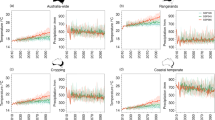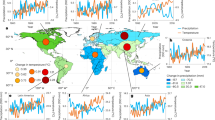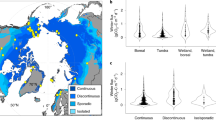Abstract
Croplands are the foundation of global food security and represent the largest nitrogen flows on Earth. Elevated atmospheric CO2 levels are a key driver of climate change with multiple impacts on food production and environmental sustainability. However, our understanding of how the cropland nitrogen cycle responds to elevated CO2 levels is not well developed. Here we demonstrate that elevated CO2 (eCO2) alone would induce a synergistic intensification of the nitrogen and carbon cycles, promoting nitrogen-use efficiency by 19% (95% confidence interval, 14–26%) and biological nitrogen fixation by 55% (95% confidence interval, 28–85%) in global croplands. This would lead to increased crop nitrogen harvest (+12 Tg yr−1), substantially lower fertilizer input requirements (−34 Tg yr−1) and an overall decline in reactive nitrogen loss (−46 Tg yr−1) under future eCO2 scenarios by 2050. The impact of eCO2 on the altered cropland nitrogen cycle would amount to US$668 bn of societal benefits by avoiding damages to human and ecosystem health. The largest benefits are expected to materialize in China, India, North America and Europe. It is paramount to incorporate the effect of rising CO2 on the nitrogen cycle into state-of-the-art Earth system models to provide robust scientific evidence for policymaking.
This is a preview of subscription content, access via your institution
Access options
Access Nature and 54 other Nature Portfolio journals
Get Nature+, our best-value online-access subscription
$29.99 / 30 days
cancel any time
Subscribe to this journal
Receive 12 digital issues and online access to articles
$119.00 per year
only $9.92 per issue
Buy this article
- Purchase on Springer Link
- Instant access to full article PDF
Prices may be subject to local taxes which are calculated during checkout





Similar content being viewed by others
Data availability
Data on the main findings can be found in the Supplementary Information. Further data supporting the findings can be found in refs. 61,62,63,64,65,66,67. Source data are provided with this paper.
References
Galloway, J. N. et al. Transformation of the nitrogen cycle: recent trends, questions, and potential solutions. Science 320, 889–892 (2008).
Tilman, D., Balzer, C., Hill, J. & Befort, B. L. Global food demand and the sustainable intensification of agriculture. Proc. Natl Acad. Sci. USA 108, 20260–20264 (2011).
Wheeler, T. & von Braun, J. Climate change impacts on global food security. Science 341, 508–513 (2013).
IPCC Climate Change 2021: The Physical Science Basis (Cambridge Univ. Press, 2021).
Xia, L. et al. Elevated CO2 negates O3 impacts on terrestrial carbon and nitrogen cycles. One Earth 4, 1752–1763 (2021).
Ainsworth, E. A. & Long, S. P. 30 years of free-air carbon dioxide enrichment (FACE): what have we learned about future crop productivity and its potential for adaptation? Glob. Chang. Biol. 27, 27–49 (2021).
Zaehle, S., Jones, C. D., Houlton, B., Lamarque, J. F. & Robertson, E. Nitrogen availability reduces CMIP5 projections of twenty-first-century land carbon uptake. J. Clim. 28, 2494–2511 (2015).
Gruber, N. & Galloway, J. N. An Earth-system perspective of the global nitrogen cycle. Nature 451, 293–296 (2008).
Yue, K. et al. Influence of multiple global change drivers on terrestrial carbon storage: additive effects are common. Ecol. Lett. 20, 663–672 (2017).
van Groenigen, K. J., Qi, X., Osenberg, C. W., Luo, Y. & Hungate, B. A. Faster decomposition under increased atmospheric CO2 limits soil carbon storage. Science 344, 508–509 (2014).
Sutton, M. A. et al. Too much of a good thing. Nature 472, 159–161 (2011).
Sinha, E., Michalak, A. M. & Balaji, V. Eutrophication will increase during the 21st century as a result of precipitation changes. Science 357, 1–5 (2017).
Kanter, D. R., Zhang, X., Mauzerall, D. L., Malyshev, S. & Shevliakova, E. The importance of climate change and nitrogen use efficiency for future nitrous oxide emissions from agriculture. Environ. Res. Lett. 11, 1–9 (2016).
Rosenzweig, C. et al. Assessing agricultural risks of climate change in the 21st century in a global gridded crop model intercomparison. Proc. Natl Acad. Sci. USA 111, 3268–3273 (2014).
Lobell, D. B., Schlenker, W. & Costa-Roberts, J. Climate trends and global crop production since 1980. Science 333, 616–620 (2011).
McGrath, J. M. & Lobell, D. B. Regional disparities in the CO2 fertilization effect and implications for crop yields. Environ. Res. Lett. 8, 014054 (2013).
Mason, R. E. et al. Evidence, causes, and consequences of declining nitrogen availability in terrestrial ecosystems. Science 376, eabh3767 (2022).
Beach, R. H. et al. Combining the effects of increased atmospheric carbon dioxide on protein, iron, and zinc availability and projected climate change on global diets: a modelling study. Lancet Planet. Heal. 3, e307–e317 (2019).
Wang, C., Sun, Y., Chen, H. Y. H. & Ruan, H. Effects of elevated CO2 on the C:N stoichiometry of plants, soils, and microorganisms in terrestrial ecosystems. Catena 201, 105219 (2021).
Luo, Y., Hui, D. & Zhang, D. Elevated CO2 stimulates net accumulations of carbon and nitrogen in land ecosystems: a meta-analysis. Ecology 87, 53–63 (2006).
Leakey, A. D. B. et al. Elevated CO2 effects on plant carbon, nitrogen, and water relations: six important lessons from FACE. J. Exp. Bot. 60, 2859–2876 (2009).
Liang, J., Qi, X., Souza, L. & Luo, Y. Processes regulating progressive nitrogen limitation under elevated carbon dioxide: a meta-analysis. Biogeosciences 13, 2689–2699 (2016).
Wuepper, D., Le Clech, S., Zilberman, D., Mueller, N. & Finger, R. Countries influence the trade-off between crop yields and nitrogen pollution. Nat. Food 1, 713–719 (2020).
Stevens, C. J. Nitrogen in the environment. Science 363, 578–580 (2019).
Bouskill, N. J., Riley, W. J. & Tang, J. Y. Meta-analysis of high-latitude nitrogen-addition and warming studies implies ecological mechanisms overlooked by land models. Biogeosciences 11, 6969–6983 (2014).
Gu, B. et al. Cost-effective mitigation of nitrogen pollution from global croplands. Nature 613, 77–84 (2023).
Wang, B. et al. Air warming and CO2 enrichment increase N use efficiency and decrease N surplus in a Chinese double rice cropping system. Sci. Total Environ. 706, 136063 (2020).
Lam, S. K. et al. Effect of elevated carbon dioxide on growth and nitrogen fixation of two soybean cultivars in northern China. Biol. Fertil. Soils 48, 603–606 (2012).
Moser, G. et al. Explaining the doubling of N2O emissions under elevated CO2 in the Giessen FACE via in-field 15N tracing. Glob. Chang. Biol. 24, 3897–3910 (2018).
Taub, D. R. & Wang, X. Why are nitrogen concentrations in plant tissues lower under elevated CO2? A critical examination of the hypotheses. J. Integr. Plant Biol. 50, 1365–1374 (2008).
Wang, W. et al. Yield, dry matter distribution and photosynthetic characteristics of rice under elevated CO2 and increased temperature conditions. Field Crops Res. 248, 107605 (2020).
Sardans, J. et al. Changes in nutrient concentrations of leaves and roots in response to global change factors. Glob. Chang. Biol. 23, 3849–3856 (2017).
Guo, Y. et al. Enhanced leaf turnover and nitrogen recycling sustain CO2 fertilization effect on tree-ring growth. Nat. Ecol. Evol. 6, 1271–1278 (2022).
The State of Food Security and Nutrition in the World 2021 (FAO, IFAD, UNICEF, WFP and WHO, 2021); https://doi.org/10.4060/cb4474en
Zhang, X. et al. Managing nitrogen for sustainable development. Nature 528, 51–59 (2015).
Liu, L. et al. Exploring global changes in agricultural ammonia emissions and their contribution to nitrogen deposition since 1980. Proc. Natl Acad. Sci. USA 119, 1–9 (2022).
Quemada, M. et al. Exploring nitrogen indicators of farm performance among farm types across several European case studies. Agric. Syst. 177, 102689 (2020).
van Grinsven, H. J. M. et al. Establishing long-term nitrogen response of global cereals to assess sustainable fertilizer rates. Nat. Food 3, 122–132 (2022).
Steffen, W. et al. Planetary boundaries: guiding human development on a changing planet. Science 347, 1259855 (2015).
Zhu, P. et al. Warming reduces global agricultural production by decreasing cropping frequency and yields. Nat. Clim. Change https://doi.org/10.1038/s41558-022-01492-5 (2022).
Rennert, K. et al. Comprehensive evidence implies a higher social cost of CO2. Nature 610, 687–692 (2022).
Dobermann, A. et al. Responsible plant nutrition: a new paradigm to support food system transformation. Glob. Food Sec. 33, 100636 (2022).
Shyamsundar, P. et al. Fields on fire: alternatives to crop residue burning in India. Science 365, 536–538 (2019).
Korres, N. E. et al. Cultivars to face climate change effects on crops and weeds: a review. Agron. Sustain. Dev. 36, 1–22 (2016).
Springmann, M. et al. Global and regional health effects of future food production under climate change: a modelling study. Lancet 387, 1937–1946 (2016).
Lesk, C., Coffel, E. & Horton, R. Net benefits to US soy and maize yields from intensifying hourly rainfall. Nat. Clim. Change 10, 819–822 (2020).
Chrysafi, A. et al. Quantifying Earth system interactions for sustainable food production via expert elicitation. Nat. Sustain. https://doi.org/10.1038/s41893-022-00940-6 (2022).
Bowles, T. M. et al. Addressing agricultural nitrogen losses in a changing climate. Nat. Sustain. 1, 399–408 (2018).
Hedges, L. V., Gurevitch, J. & Curtis, P. S. The meta-analysis of response ratios in experimental ecology. Ecology 80, 1150 (1999).
Pittelkow, C. M. et al. Productivity limits and potentials of the principles of conservation agriculture. Nature 517, 365–368 (2015).
Rosenberg, M., Adams, D. & Gurevitch, J. MetaWin: statistical software for meta-analysis, v.2.0 (Sinauer, 2000).
Viechtbauer, W. Conducting meta-analyses in R with the metafor. J. Stat. Softw. 36, 1–48 (2010).
Beusen, A. H. W. et al. Exploring river nitrogen and phosphorus loading and export to global coastal waters in the Shared Socio-economic Pathways. Global Environ. Change 72, 102426 (2022).
Gu, B. et al. Toward a generic analytical framework for sustainable nitrogen management: application for China. Environ. Sci. Technol. 53, 1109–1118 (2019).
Gu, B., Ju, X., Chang, J., Ge, Y. & Vitousek, P. M. Integrated reactive nitrogen budgets and future trends in China. Proc. Natl Acad. Sci. USA 112, 8792–8797 (2015).
Gu, B. et al. Abating ammonia is more cost-effective than nitrogen oxides for mitigating PM2.5 air pollution. Science 374, 758–762 (2021).
Zhang, X. et al. Societal benefits of halving agricultural ammonia emissions in China far exceed the abatement costs. Nat. Commun. 11, 1–10 (2020).
Kristal, S. L., Randall-Kristal, K. A. & Thompson, B. M. The Society for Academic Emergency Medicine’s 2004–2005 emergency medicine faculty salary and benefit survey. Acad. Emerg. Med. 13, 548–558 (2006).
van Grinsven, H. J. M. et al. Costs and benefits of nitrogen for Europe and implications for mitigation. Environ. Sci. Technol. 47, 3571–3579 (2013).
Sobota, D. J., Compton, J. E., McCrackin, M. L. & Singh, S. Cost of reactive nitrogen release from human activities to the environment in the United States. Environ. Res. Lett. 10, 025006 (2015).
Fick, S. E. & Hijmans, R. J. WorldClim 2: new 1-km spatial resolution climate surfaces for global land areas. Int. J. Climatol. 37, 4302–4315 (2017).
Global Land Data Assimilation System (NASA, accessed 6 July 2022); https://ldas.gsfc.nasa.gov/gldas/soils
Beck, H. E. et al. Present and future Köppen–Geiger climate classification maps at 1-km resolution. Sci. Data 5, 180214 (2018).
The Future of Food and Agriculture: Alternative Pathways to 2050 (FAO, 2018).
Cheng, W. et al. Global monthly gridded atmospheric carbon dioxide concentrations under the historical and future scenarios. Sci. Data 9, 1–13 (2022).
FAOSTAT (FAO, 2022); https://www.fao.org/faostat/en/#data
United Nations Commodity Trade Statistics Database (United Nations, accessed 24 February 2022); https://comtrade.un.org/
Acknowledgements
This study was supported by the National Key Research and Development Project of China (2022YFE0138200 and 2022YFD1700700) and the National Natural Science Foundation of China (42261144001 and 42061124001) received by B.G. We thank M. Zheng, Z. Qiu and X. Zhang for their hard work on metadata collection and validation.
Author information
Authors and Affiliations
Contributions
B.G. and J.C. designed the study. J.C. prepared and analysed the data. B.G. and J.C. interpreted the results and wrote the first draft of the paper. X.Z. provided support for modelling and impact assessment. S.R. revised the paper. C.W. and H.C. collected data from climate change experiments. S.W. and P.H. provided visualization support. H.J.M.v.G. provided modelling support.
Corresponding author
Ethics declarations
Competing interests
The authors declare no competing interests.
Ethics statement
We confirm that this study adheres to all applicable ethical regulations. As an independent study, there was no formal board, committee or institution that approved the study protocol.
Peer review
Peer review information
Nature Sustainability thanks Shiqiang Wan, Li An and the other, anonymous, reviewer for their contribution to the peer review of this work.
Additional information
Publisher’s note Springer Nature remains neutral with regard to jurisdictional claims in published maps and institutional affiliations.
Extended data
Extended Data Fig. 1 Effects of elevated CO2 levels on crop yield and grain N content in global croplands.
Effects of elevated CO2 levels on (a) crop yield and (b) grain N content by crop groups; (c) crop yield by manipulation methods, including FACE (Free-air CO2 Enrichment Experiment), OTC (Open-top Chamber), and GC (Growth Chamber); (d) BNF by climate zones. The error bars indicate the 95% confidence interval of the mean, which is significant if the 95% confidence interval does not overlap zero. Numbers in the parentheses denote the number of observations in the meta-analysis.
Extended Data Fig. 2 Meta-regressions between response ratios (RR%) of variables and environmental factors.
(a) RR of crop yield versus ΔCO2 (elevated CO2 level relative to ambient CO2); (b) RR of NUE versus MAP (mean annual precipitation); (c) RR of NH3 versus ΔCO2; (d) RR of N2O versus ΔCO2. The bubbles represent the response ratios of individual observations, with bubble sizes indicating the weights of the response ratios. The P values were obtained from a two-sided F-test for the fitting lines with no adjustments for multiple comparisons. Unit ppm denotes parts per million.
Extended Data Fig. 3 Meta-regressions between logarithm-transformed response ratios (LnRR) of variables for specific crop type and environmental factors.
(a) LnRR of yield versus ΔCO2 for barley; (b) LnRR of yield versus MAT (mean annual temperature) for maize; (c) LnRR of yield versus MAP (mean annual precipitation) for rice. The bubbles represent the response ratios of individual observations, with bubble sizes indicating the weights of the response ratios. The P values were obtained from a two-sided F-test for the fitting lines with no adjustments for multiple comparisons.
Extended Data Fig. 4 Scenario design of the study.
(a) Simplified narratives of the scenarios. (b) Historical and future atmospheric CO2 levels in the baseline scenario and elevated CO2 scenario during 1950–2100.
Extended Data Fig. 5 N input of global cropland and their changes under elevated CO2 SSP2-4.5 scenario relative to baseline scenario in 2050.
Biological N fixation (BNF) in baseline scenario (a), eCO2 scenario (b), and ΔBNF (c); Fertilizer in baseline scenario (d), eCO2 scenario (e), and ΔFertilizer (f); Manure in baseline scenario (g), eCO2 scenario (h), and ΔManure (i); Deposition in baseline scenario (j), eCO2 scenario (k), and ΔDeposition (l). Values in the legend reflect the average annual N budget from croplands within a grid cell (0.5 by 0.5 degree). The base map is applied without endorsement from GADM data (https://gadm.org/).
Extended Data Fig. 6 Reactive N loss of global cropland and their changes under elevated CO2 SSP2-4.5 scenario relative to baseline scenario in 2050.
NH3 in baseline scenario (a), eCO2 scenario (b), and ΔNH3 (c); N2O in baseline scenario (d), eCO2 scenario (e), and ΔN2O (f); NOx in baseline scenario (g), eCO2 scenario (h), and ΔNOx (i); N leaching and runoff in baseline scenario (j), eCO2 scenario (k), and ΔN leaching and runoff (l). Values in the legend reflect the average annual N budget from croplands within a grid cell (0.5 by 0.5 degree). The base map is applied without endorsement from GADM data (https://gadm.org/).
Extended Data Fig. 7 CHANS (Coupled Human and Natural System) model with detailed representation of cropland sub-system.
(a) Overview of the CHANS model. The CHANS model contains 14 subsystems that are divided into four functional groups: processors (indicated by a green outline), consumers (red outline), removers (seagreen outline), and life-supporters (blue outline). The focus of this study is on the cropland sub-system. (b) Detailed representation of cropland sub-system. The model utilizes input data from multiple sources including social-economic data (indicated by orange) and N cycling data (indicated by blue). The N flows associated with N input, harvest, and surplus serve as CHANS model variables in the N-balance operation, which generates outputs of cropland N budgets for different geographical regions. Additionally, the CHANS model enables impact assessment to estimate the monetized impacts on health and the environment.
Extended Data Fig. 8 Methodology framework.
Meta-analysis is conducted to assess the impacts of elevated CO2 (eCO2) on N and C cycles. Crop N budgets are generated based on the IMAGE and CHANS models using multi-source data. In scenario analysis, we simulate rising CO2 levels by integrating the eCO2 impacts on N and C cycles in meta-analysis into the CHANS model for optimizing parameterization and projecting future cropland N budgets.
Supplementary information
Supplementary Information
Supplementary methods, Fig. 1, Tables 1 and 2 and references.
Source data
Source Data Figs. 1, 2, 3, 4 and 5
Statistical source data.
Source Data Extended Data Figs. 1, 2, 3, 4, 5 and 6
Statistical source data.
Rights and permissions
Springer Nature or its licensor (e.g. a society or other partner) holds exclusive rights to this article under a publishing agreement with the author(s) or other rightsholder(s); author self-archiving of the accepted manuscript version of this article is solely governed by the terms of such publishing agreement and applicable law.
About this article
Cite this article
Cui, J., Zhang, X., Reis, S. et al. Nitrogen cycles in global croplands altered by elevated CO2. Nat Sustain 6, 1166–1176 (2023). https://doi.org/10.1038/s41893-023-01154-0
Received:
Accepted:
Published:
Issue Date:
DOI: https://doi.org/10.1038/s41893-023-01154-0
This article is cited by
-
Elevated CO2 levels promote both carbon and nitrogen cycling in global forests
Nature Climate Change (2024)
-
An Elevated CO2 Concentration Improves the Photosynthetic Efficiency and Grain Yield of Rice Plants but Concurrently Increases the Nitrogen Fertilizer
Journal of Soil Science and Plant Nutrition (2024)



